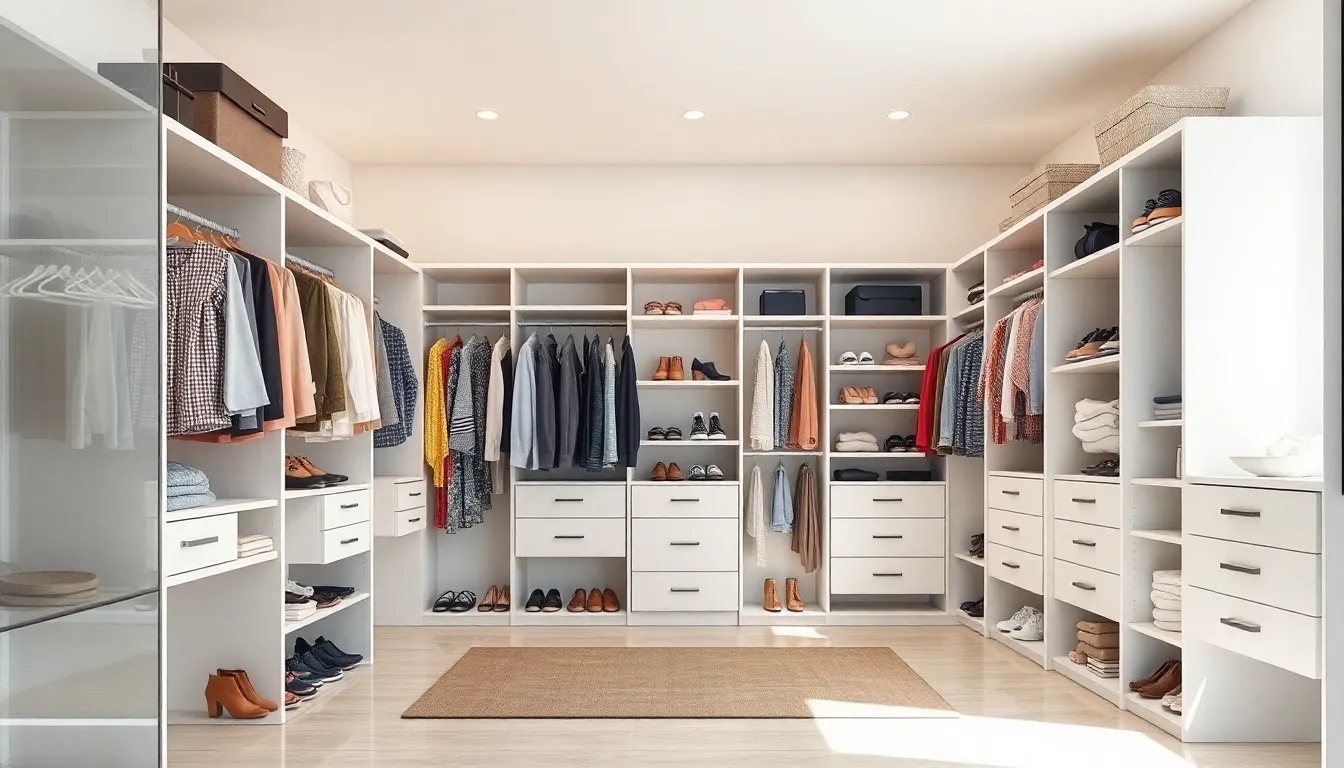A well-organized closet can transform daily routines and elevate the overall feel of a home. With busy lifestyles, it’s easy for closets to become chaotic spaces filled with clothes, shoes, and accessories that are hard to navigate. However, taking the time to declutter and organize can lead to a more functional and visually appealing area.
Effective closet organization not only saves time but also reduces stress. It allows individuals to easily find what they need while maximizing available space. From clever storage solutions to simple sorting techniques, anyone can master the art of closet organization and create a serene sanctuary that reflects their personal style. Embracing these strategies can make a significant difference in how one interacts with their wardrobe and belongings.
Table of Contents
ToggleImportance Of Closet Organization
Closet organization plays a significant role in creating a functional living space. A neat closet contributes to a smoother daily routine and enhances the overall home environment.
Benefits Of A Well-Organized Closet
- Time Savings: An organized closet reduces the time spent searching for items. With a clear layout, individuals can quickly locate clothing, accessories, and shoes.
- Reduced Stress: Clutter contributes to anxiety. A tidy closet provides a sense of order, leading to a calmer mindset.
- Increased Space: Proper organization maximizes available storage. Utilizing vertical space and storage solutions can free up room for additional items.
- Enhanced Visual Appeal: A well-arranged closet looks pleasant and can even inspire creativity in outfit choices.
- Personalized Style Reflection: It showcases personal style. An organized closet allows individuals to curate and display their wardrobe effectively.
Impact On Daily Life
- Improved Morning Routines: Quick access to clothing streamlines getting ready each day. Less time looking for items means more time for essential activities.
- Easier Outfit Planning: Visualization of available clothing aids in making informed decisions about what to wear for different occasions.
- Promotes Sustainability: Knowing what one owns helps in making conscious decisions regarding new purchases, reducing unnecessary consumption and promoting eco-friendly behaviors.
- Boosts Motivation: An inviting closet can motivate individuals to maintain daily organization and appearance.
- Facilitates Decluttering: Regular organization encourages evaluating items, leading to furniture that stays current with lifestyle needs.
Types Of Closet Systems

Understanding various types of closet systems helps individuals choose the best option for their space. Different styles cater to diverse needs and preferences.
Walk-In Closets
Walk-in closets provide ample space, offering a luxurious and organized storage solution. These closets often feature designated areas for clothing, shoes, and accessories. Walk-in options typically include:
- Shelving: Adjustable shelves accommodate varying items like shoes, bags, and folded clothes.
- Hanging rods: Double or single rods maximize vertical space for hanging garments.
- Drawers: Built-in drawers offer hidden storage for smaller items and keep the closet tidy.
Reach-In Closets
Reach-in closets are popular in smaller spaces, allowing efficient organization without compromising room flow. These systems can be customized with:
- Rods: Single or double rods help hang clothing while utilizing vertical space effectively.
- Shelves: Fixed or adjustable shelves provide storage for shoes and folded garments.
- Baskets: Wire or cloth baskets maximize organization and accessibility for frequently used items.
Custom Closet Solutions
- Professional design: Consulting with designers creates functional layouts that utilize every inch effectively.
- Unique features: Built-in lighting, mirrored doors, and sliding shelves enhance usability and aesthetics.
- Flexibility: Adjustable components allow for future changes as storage needs evolve or lifestyles shift.
Essential Closet Organization Tools
Effective closet organization relies on the right tools. Utilizing suitable storage options greatly enhances functionality and accessibility.
Shelving Options
Shelving systems optimize vertical space, providing organized storage for various items. Adjustable shelves accommodate different heights and sizes of clothing, maximizing available storage. Install floating shelves for an open feel or opt for built-in units for stability. Use corner shelves to utilize otherwise wasted space efficiently. Each design choice allows flexibility to adapt the closet layout based on changing needs.
Hangers And Hooks
Hangers and hooks play a vital role in maintaining an organized closet. Use slim hangers to save space and create a uniform look. Tiered hangers allow for storing multiple items vertically, ideal for scarves or ties. Wall-mounted hooks offer additional storage for bags, accessories, or frequently used items, keeping them accessible yet out of the way.
Storage Bins And Baskets
Storage bins and baskets facilitate organization by grouping like items together. Opt for clear bins to easily view contents or stylish woven baskets for aesthetic appeal. Label each container to quickly identify contents, enhancing efficiency during wardrobe selection. Utilize under-shelf bins to capitalize on unused space and create a neat appearance. These tools contribute to maintaining a clutter-free environment.
Steps To Achieve Perfect Closet Organization
Achieving perfect closet organization involves a systematic approach. Following these steps can lead to a more efficient and aesthetically pleasing space.
Decluttering Your Closet
Decluttering starts with removing everything from the closet. Sorting items into three categories: keep, donate, and discard simplifies the process. Items that haven’t been worn in over a year typically belong in the donate or discard piles. Evaluating the condition of each item is crucial for ensuring the wardrobe remains functional. Once sorted, cleaning the closet space prepares it for the next steps.
Categorizing Your Items
Categorizing items streamlines organization and storage. Group similar items together, such as clothing, shoes, and accessories. Within each category, further arrange based on frequency of use, color, or season. Utilizing specific containers for each category enhances visibility and accessibility. For example, place formal wear in one area and casual wear in another, making daily choices easier.
Maximizing Space Efficiently
Maximizing space requires smart solutions. Use vertical storage with shelves or hanging organizers to keep items off the floor. Invest in multi-functional furniture, like ottomans with storage, for added utility. Employ drawer dividers for smaller items like socks and accessories to maintain order. Hooks on the back of doors or walls can hold bags or hats, freeing up floor space. This strategic use of space not only increases storage capacity but also improves overall functionality.
Maintenance Of Closet Organization
Maintaining an organized closet requires consistent effort and proactive strategies. Implementing effective practices helps ensure that the closet remains functional and clutter-free.
Tips For Keeping Your Closet Organized
- Regularly Assess items to evaluate necessity. Remove those not used within the last year.
- Use Clear Bins for storage, allowing visibility of contents and simplifying the search process.
- Establish Zones for specific categories, such as formal wear, casual outfits, and accessories, promoting easy access.
- Adopt a One-In-One-Out Rule whereby every new item requires the removal of an existing one, preventing clutter accumulation.
- Label Storage Solutions to enhance visibility and encourage consistent item placement.
- Prioritize Accessibility by storing frequently used items at eye level and seasonal items higher up or at the back.
- Implement a Weekly Check-In to quickly address any disarray or shifted items, maintaining order over time.
Seasonal Clean-Outs
- Schedule Regular Clean-Outs at each season change to assess items relevant to current weather and activities.
- Sort Seasonal Clothing into categories such as keep, donate, or discard, ensuring functional outfits for the upcoming season.
- Store Off-Season Items in labeled bins or vacuum bags, maximizing space and preserving condition.
- Evaluate Wardrobe Needs and adjust based on lifestyle changes, ensuring all items match current preferences and activities.
- Incorporate a Donation Box for easy access, simplifying the process of removing items regularly.
- Clean and Refresh the closet space during seasonal transitions, ensuring a welcoming environment for next use.
- Review Accessories and shoes, discarding damaged or unused items to keep the closet streamlined.
Regular maintenance, strategic organization, and diligent cleaning efforts foster a lifelong commitment to a well-organized closet.
A well-organized closet can significantly transform daily life. By investing time in decluttering and implementing effective storage solutions, individuals can create a serene space that enhances both functionality and aesthetics. The benefits extend beyond just saving time; a tidy closet fosters a stress-free environment and reflects personal style.
Maintaining organization requires ongoing effort and mindful practices. Regular assessments and strategic categorization ensure that the closet remains a source of inspiration rather than frustration. With the right approach, anyone can enjoy the lasting advantages of a beautifully organized closet, making everyday routines smoother and more enjoyable.



